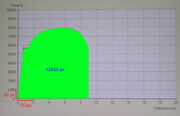- 1,178
- 407
let's try another example with a bit longer and thicker speciman
https://www.youtube.com/watch?v=D8U4G5kcpcM

10 - kN - 66 px
2 mm - 37 px
Area below the curve: 120352 px
120352*(10/66)*(2/37) = 985.68 Joules (Street level)
Peak force: 36.88 kN (Class 5)
https://www.youtube.com/watch?v=D8U4G5kcpcM

10 - kN - 66 px
2 mm - 37 px
Area below the curve: 120352 px
120352*(10/66)*(2/37) = 985.68 Joules (Street level)
Peak force: 36.88 kN (Class 5)
